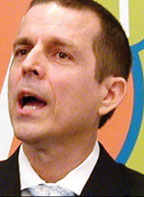
 Words matter: Communicating to end HIV-related stigma
Words matter: Communicating to end HIV-related stigma
Richard Wolitski, Ph.D., Acting Director, Office of HIV/AIDS and Infectious Disease Policy, U.S. Department of Health and Human Services
By Richard Wolitski, Ph.D
`Words matter. They can motivate, empower, and lift people up. They can also do a great deal of damage and tear people down.
I was reminded of this in many different ways at the meeting on HIV stigma that the Office of National AIDS Policy (ONAP) and the National Institute of Mental Health (NIMH) recently held at the White House. We heard about how stigma is experienced by people living with HIV in the United States and around the world, what is being done to reduce it, and how we are measuring progress in addressing it.
What really stayed with me afterwards is the power that words have to create stigma in the daily lives of people with HIV. This is a reality that everyone living with HIV has experienced. What is less recognized, however, is the negative impact that words have on the lives of people who are HIV-negative and trying to stay that way. Gay men, transgender women, sex workers, people who inject drugs, and others at risk for HIV infection are sometimes treated poorly when they take actions to protect their health, such as being tested for HIV or asking for pre-exposure prophylaxis (PrEP).
Stigma can also be a by-product of how we talk about HIV data. David Matthews from Bridging Access to Care in Brooklyn, New York, spoke at the stigma meeting about how the recently released data on lifetime risk of HIV diagnosis can stigmatize Black gay, bisexual, and other men who have sex with men (MSM) and potentially undermine the efforts of uninfected Black gay men and others to stay HIV-negative.
His words resonated with me. On the one hand, those of us who work for public health have a responsibility to provide people with accurate information about their risk of HIV infection and other threats to their health. Information about how risk accumulates over a lifetime may help some people make a more realistic assessment of their own risk and motivate some to take action. People have a right to know, and we have an obligation to make the data available. This is true even if it is as alarming as the data about lifetime HIV risk that were released at the 2016 Conference on Retroviruses and Opportunistic Infections (CROI).
At the same time, however, our ultimate goals are to prevent illness and disease and to improve people’s health and wellbeing. This means we need to be mindful of how data are communicated and their un-intended effects, so that we don’t undercut public health efforts. David Matthews noted that the framing of the data about the lifetime risk of black gay, bi-sexual, and other MSM undermined his own efforts to stay negative by making HIV infection seem almost inevitable. This is clearly not the reaction we want to encourage.
It’s remarkable that one in two Black MSM, three in four Latino MSM, and, overall, five in six MSM will remain HIV-negative, even though the odds are stacked against them. Many men are doing what they need to do in order to protect them-selves and others from getting HIV. These data remind us that despite the risks, the majority of gay, bisexual and other MSM can, and will, remain HIV negative for a lifetime.
We need to recognize and celebrate those who are getting tested regularly, using condoms, taking PrEP, or using other effective risk-reduction strategies that are keeping them free from HIV infection. And we need to recognize and celebrate the efforts of people living with HIV who are doing their part to make sure they do not pass HIV to anyone.
Highlighting these efforts is an important step toward reducing HIV-related stigma.
The National HIV/AIDS Strategy (NHAS) explicitly recognizes the impact stigma has on the domestic HIV epidemic: “Stigma and discrimination must be eliminated in order to diminish barriers to HIV prevention, testing, and care.” The NHAS offers a set of recommendations on tackling stigma and discrimination, and ONAP is developing an NHAS indicator to monitor our national progress on reducing stigma.
Together, we can make real progress to reduce stigma and ensure that fewer people get HIV. We need to learn from those who are successfully ad-dressing stigma, replicate their approaches in other places and communities, and accelerate efforts to achieve the Strategy’s vision of a nation that is free from stigma and discrimination.
Let’s start by recognizing and applauding the efforts of millions of Americans to stay HIV-negative and continue to support them in winning their personal battles against this virus and the stigma that helps it to spread. Unless we speak out against that stigma, we can-not hope to achieve our national goals.
From AIDS.gov


Be the first to comment